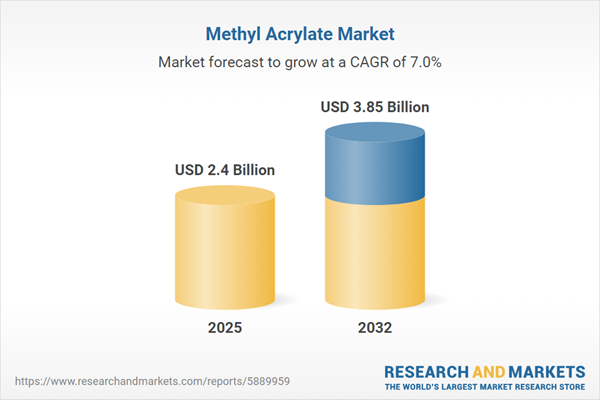Speak directly to the analyst to clarify any post sales queries you may have.
Senior executives face growing complexity in the methyl acrylate market as regulatory frameworks, supply networks, and technical standards evolve in real time. Effective procurement decisions depend on current, relevant insights to support compliance, risk control, and operational continuity.
Methyl Acrylate Market Snapshot
The global methyl acrylate market is valued at USD 2.24 billion, with expectations to reach USD 2.40 billion by 2025 and a projected 7.01% CAGR through 2032. This growth is supported by diverse procurement needs across coatings, adhesives, electronics, cosmetics, and specialty chemical sectors. Suppliers are responding to tighter regulatory standards by boosting traceability, strengthening technical documentation, and adopting transparent sourcing protocols. These measures increase the reliability of global supply channels, ensuring that buyers maintain compliance in dynamic jurisdictions.
Methyl Acrylate Market: Scope & Segmentation
Segmentation enables senior decision-makers to align procurement with evolving business requirements while managing risks within layered supplier networks. By applying targeted segmentation, organizations gain agility in sourcing and partner selection.
- Grade: Choose from cosmetic, food, or industrial grades to match specific end-use and regulatory priorities across production sectors.
- Purity: Options including 80–95%, 95–99%, and over 99% support selection for precise compliance and manufacturing standards.
- Form: Emulsifiable or liquid forms offer flexibility for streamlined processing, ensuring adaptability for both large-scale and R&D-driven initiatives.
- Product Grade: Specialty grades are tailored for applications such as personal care, electronics, or advanced industrial processes where certification or unique performance is necessary.
- Application: Areas range from adhesives, sealants, pharmaceuticals, and plastics to chemicals, coatings, and rubber—each with unique sourcing and documentation criteria.
- Distribution Channel: Organizations may leverage direct sales, partner networks, digital platforms, or e-commerce channels to optimize regional and global fulfillment.
- Region: Target supply networks across the Americas, EMEA, and Asia-Pacific, including coverage of the United States, China, Europe, India, Japan, and emerging Middle Eastern and African markets.
- Covered Companies: Benchmarked suppliers include China Petroleum & Chemical Corporation, BASF SE, The Dow Chemical Company, Arkema SA, Evonik Industries AG, Mitsubishi Chemical Holdings Corporation, LG Chem Ltd., Sumitomo Chemical Co., Ltd., Eastman Chemical Company, and Celanese Corporation.
Methyl Acrylate Market: Key Takeaways for Senior Leaders
- Adaptable product and supplier management empowers organizations to quickly address emerging market and sourcing shifts without jeopardizing continuity.
- Comprehensive compliance documentation and strong technical support simplify global operations and audit preparation.
- Technology advances in processing and catalysis underpin consistent supply while helping mitigate logistical and supply chain risks.
- Strategic supplier partnerships and robust logistics networks maintain reliable material flow and reduce the risk of operational delays.
- Factoring in ESG criteria during supplier evaluation supports long-term procurement objectives and strengthens alignment with corporate sustainability mandates.
Tariff Impact and Strategic Response
Recent adjustments in U.S. tariffs have led procurement leaders to diversify supplier portfolios by emphasizing regional and domestic sourcing. Vendors leveraging tariff exemptions enhance their standing as distribution partners reevaluate inventory and pursue new collaborations. These actions are key to preserving cost efficiency and delivery reliability during policy fluctuations.
Methodology & Data Sources
The research integrates direct consultation with industry experts, meticulous review of regulatory and technical sources, and rigorous cross-verification from multiple data providers. This methodology ensures that the findings meet the requirements of procurement and supply chain leaders.
Methyl Acrylate Market: Why This Report Matters
- Enables senior executives to forecast procurement and supply chain risk, maintaining operational continuity amid changing regulatory and technical landscapes.
- Establishes a clear benchmark for supplier selection and distribution channel assessment, reducing complexity in global chemical sourcing.
- Equips organizations to recalibrate procurement strategy as tariffs and environmental compliance standards evolve.
Conclusion
This report empowers decision-makers to reinforce supplier relationships, refine procurement processes, and anticipate new challenges in the methyl acrylate market for agile business operations.
Additional Product Information:
- Purchase of this report includes 1 year online access with quarterly updates.
- This report can be updated on request. Please contact our Customer Experience team using the Ask a Question widget on our website.
Table of Contents
3. Executive Summary
4. Market Overview
7. Cumulative Impact of Artificial Intelligence 2025
Companies Mentioned
The companies profiled in this Methyl Acrylate market report include:- China Petroleum & Chemical Corporation
- BASF SE
- The Dow Chemical Company
- Arkema SA
- Evonik Industries AG
- Mitsubishi Chemical Holdings Corporation
- LG Chem Ltd.
- Sumitomo Chemical Co., Ltd.
- Eastman Chemical Company
- Celanese Corporation
Table Information
| Report Attribute | Details |
|---|---|
| No. of Pages | 189 |
| Published | November 2025 |
| Forecast Period | 2025 - 2032 |
| Estimated Market Value ( USD | $ 2.4 Billion |
| Forecasted Market Value ( USD | $ 3.85 Billion |
| Compound Annual Growth Rate | 7.0% |
| Regions Covered | Global |
| No. of Companies Mentioned | 11 |









